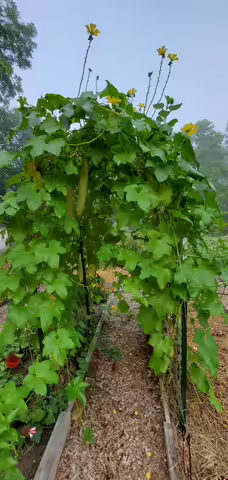Most gardeners who have planted a summer squash in their vegetable garden can attest to the prolific growth of healthy squash vines. And in good years, many can also recount the bountiful harvest, with fruits ripening faster than you can pick them at times. I think we’ve all found those enormous zucchinis that seemed to grow overnight like something out of jack and the beanstalk.
Squash are members of the cucurbit family (Cucurbitaceae), which includes so many of our garden mainstays, such as cucumber, zucchini, butternut squash, watermelon and other melons. Beyond the edible types, many types of squash are also grown for utilitarian purposes, which we often refer to as gourds. Worldwide, squash have been cultivated for thousands of years and the shapes and sizes of these versatile veggies abound.
Growing Loofas
This year, we tried something new and planted a gourd that many of us may recognize in its harvested form, but probably would wonder about it if we saw it in the garden. Luffa aegyptiaca is the botanical name for the gourd that produces loofah sponges, which are a popular household commodity that I am sure many of us have encountered.
To be honest, I always thought that loofah sponges came from some kind of sea creature. They remind me of living sponges, which are organisms harvested from oceans and used as domestic sponges.
A loofah sponge is simply an overripe gourd that is allowed to dry out on the vine. At the ideal harvest time, the skin becomes loose and dry which allows you to easily peel it off. Inside is an amazing network of dried, stringy squash in a fibrous, tubular mat of tissue. It is then left out to further dry and harden, creating the multiuse sponge material we see marketed as “loofas”.
So far, our loofa growing project has worked out well and we should have nice crop to harvest in the next month or so. However, we did get an early start, growing seedlings under grow lights before the frost-free date. My wife started the seeds along with a few other veggies back in March.
The early start is needed to allow enough time for the gourds to fully ripen, since they can take up to 200 days to reach maturity. Like other squash, Luffa is edible if harvested early enough. They are pretty like a zucchini if picked at around 6-8 inches in length. However, if left to become loofas, they may reach up to 2ft in length, requiring the long growing season to gain size and slowly dry out on the vine. They do need to be harvested before a frost, because the cold will really zap this warm-season vegetable and can ruin unharvested loofas.
Trellises
A trellis or support structure of some kind is required so ripening gourds can freely hang and slowly dry with exposure to air.
We used a cattle panel, which is a rigid 12ft section of fence, bent in a large U-shape over one of our garden paths to host the loofas.
At first, I was just dying to see them stretch up the empty, ugly-looking fence. As the growing season has progressed, they’ve taken off and absolutely filled every available space. Each time I’ve been in the garden there are new tendrils reaching out in all directions to grasp and engulf anything they may contact. As opposed to cutting off the sprawling growth, I’ve redirected back toward the trellis to maximize health and productivity of the plants in the hopes of larger loofas.
The inspiration for growing loofas really came from a desire to have a cool trellis in our vegetable gardening space. To add to the vertical allure, my wife planted sunflowers around the trellis as well, which are now serving as both Luffa vine support and showy flowers. Time will tell if our loofa harvest will be bountiful, but it has been an enjoyable plant to watch grow this season.

